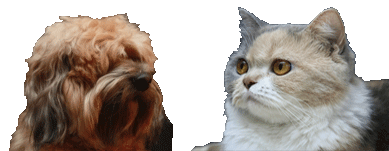Information about the Papillon
The Papillon (from the French word for butterfly), also called the Continental Toy Spaniel, is a breed of dog of the Spaniel type. One of the oldest of the toy spaniels, it derives its name from its characteristic butterfly-like look of the long and fringed hair on the ears. A papillon with dropped ears is called a Phalène (French for moth). The small head is slightly rounded between the ears with a well defined stop. The muzzle is somewhat short, thin tapering to the nose. The dark, medium sized, round eyes have thin black rims, often extending at the junction of the eyelids towards the ears. The large ears can either be erect or dropped with rounded tips. The teeth meet in a scissors bite. The long tail is set high carried over the body, and covered with long, fine hair. Dewclaws are sometimes removed. The straight, long, fine, single coat has extra frill on the chest, ears, back of the legs and the tail. Coat color is white with patches of any color. A mask of a color other than white covers both ears and eyes from back to front.
The Papillon is a very intelligent dog that has a very easy time learning new tricks. This dog is great with kids, strangers, and other pets, but they should not be handled by young children as they are small and fragile and could be seriously injured. However, if a papillon grows up in isolation, it can tend to be slightly agressive towards other dogs. Papillons are also very playful and affectionate. Widely known as great companion dogs, with the spirit and energy to keep up with active families, but calm enough to be happy with sleeping in the arms of an equally affectionate owner. They have high energy level and require more exercise than the average companion breed. The Papillon can withstand heat but are more sensitive to cold temperatures because of their single-coated fur, and should not be left outside unattended in cold weather.
The most distinct aspect of the Papillon is its ears which are large and well fringed, giving them a butterfly wing-like appearance. Papillons are parti-colored or white with patches of any color. An all-white dog or a dog with no white is disqualified from the conformation show ring. A blaze (area of white extending down between the eyes) and noseband is preferred over a solid-colored head, but not required. Nose, eye-rims, and lips should be black. Paw pads vary in color from black to pink, depending on the coloring of the dog.
Papillons can be registered with the American Kennel Club.
The American Kennel Club goes on to indicate in the breed standard, the following faults shall be severely penalized: Color other than white not covering both ears, back and front, or not extending from the ears over both eyes. A slight extension of the white collar onto the base of the ears, or a few white hairs interspersed among the color, shall not be penalized, provided the butterfly appearance is not sacrificed.
The papillon’s large, butterfly-like ears and symmetrical face gave the breed its name.
There are two ear variations of this breed, the completely upright ears of the more common papillon, and the dropped spaniel-like ears of the Phalène. The American Kennel Club and the Fédération Cynologique Internationale consider the Phalène and the papillon the same breed.
The Papillon’s coat is abundant, long, fine, silky and flowing. It should also have a resilient quality and be flat on both the back and sides. There is no undercoat. Papillon puppy fur is very long, plush and soft to touch until about three months old. It may take up to two years for a Papillon to develop the long fringes of hair that sprout off of its ears and chest.
The Papillon’s ears are well-fringed with the inside covered with silken fur of medium length. Tail is long, well-fringed, set on high, arched over back with fringes falling to side to form plume. The head is slightly rounded between the ears, and the muzzle is fine, tapering, and narrower than the skull with an abrupt stop. Height: from ground to shoulder blade 20-28 centimetres (7.9-11 in), over 28 centimetres (11 in) is a fault and over 30.5 centimetres (12.0 in) is a disqualification from the conformation show ring. Weight: 5-10 pounds (2.3-4.5 kg).
The proper temperament of a papillon is a happy, friendly, adventurous dog. They should not be shy or aggressive.
Papillions can live from 12 to 15 years. Some papillions can live to 16 years old. However, life expectancy highly depends on the exercise and diet of the dog.
Like any other dog, Papillons need a daily walk. Play will take care of a lot of their exercise needs, however, as with all breeds, play will not fulfill their primal instinct to walk. Dogs who do not get to go on daily walks are more likely to display behaviour problems. They will also enjoy a good romp in a safe open area off lead, such as a large fenced in yard. Papillons are a very active breed of dog, so what may be sufficient exercise for a basset is not enough for them. Papillon Breeders also recommend dog agility for papillons because of their playful and energetic attitude.
[Back]

